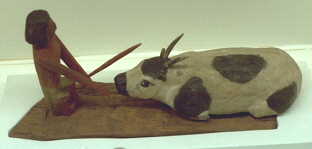
The ancient Egyptians called the banks of the Nile the Black Land because the mud that was washed downstream each year from Central Africa. The Nile flooded in June, depositing this rich, fertile mud in Egypt.The land reminded underwater until autumn.
 By November the ground was ready for plowing and then sowing.
By November the ground was ready for plowing and then sowing.
Seeds were scattered over the soil and trampled in by the hooves of sheeps and goats. During the drier periods of the year, farmers dug channels and canals to bring water to irrigate their land. In the new Kingdom, a lifting system called the shaduf was introduced to raise water from the river. The success of this farming cycle was vital. Years of low flood or drought could spell disaster. If the corps failed, people went hungry.
Farm animals included ducks, geese, pigs, sheep, and goats. Cows grazed the fringes of the desert or the greener lands of the delta region. Oxen were used for hauling plows and donkeys were widely used to carry goods.
